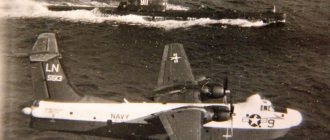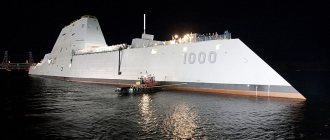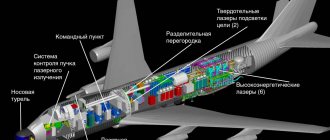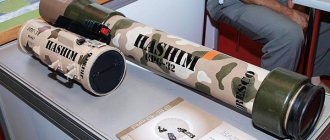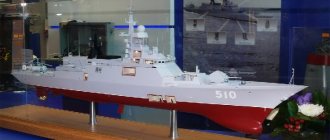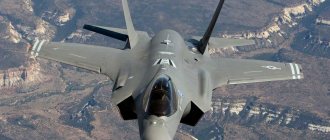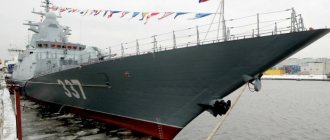| RAH-66 Comanche | |
| RAH-66 Comanche prototype in flight January 4, 1996 | |
| Type | reconnaissance and attack helicopter |
| Developer | Boeing/Sikorsky |
| Manufacturer | Boeing Helicopters[d] |
| First flight | January 4, 1996 |
| Status | program closed 02/24/2004 |
| Operators | US Army |
| Units produced | 2 |
| Media files on Wikimedia Commons | |
Boeing / Sikorsky RAH-66 Comanche
(eng. Boeing / Sikorsky RAH-66 Comanche) is an American project of a multi-role reconnaissance and attack helicopter.
Development history[ | ]
In 1991, the joint team of Boeing and Sikorsky, which presented the RAH-66 reconnaissance and combat helicopter project, was recognized as the winner of the LHX (Light Helicopter Experimental) competition. The LHX helicopters were intended to replace the Bell AH-1 attack helicopters, the Bell UH-1 utility helicopters and the Bell OH-58 and Hughes OH-6 reconnaissance helicopters. It was planned to build 4000-6000 helicopters in reconnaissance (LHX-SCAT) and multi-purpose (LHX-UTIL) versions in 1990-1994. The total development cost of the helicopters was estimated at $2.8 billion, and the production cost was estimated at $24–36 billion, making the LHX program the largest of all helicopter programs.
The first flight of the experimental RAH-66 “Comanche” helicopter took place on January 4, 1996, flight tests of the second experimental helicopter were planned to begin in 1998, and flight tests were planned for 2001 to evaluate the tactical capabilities of helicopters intended for military testing. In total, it was planned to build six helicopters for such tests. The start of serial production was planned for 2006, it was assumed that 1292 helicopters would be delivered to the US Army with a total cost of more than $34 billion.
On February 23, 2004, the US Army decided to close the Comanche helicopter program. The experience of the wars in Iraq and Afghanistan has shown that it is much cheaper and more effective to use unmanned reconnaissance aircraft than to invest in the production of reconnaissance helicopters and training pilots with the subsequent risk to vehicles and crews. At that time, more than $8 billion had already been invested in the program, in addition, the Boeing-Sikorsky association received $450–680 million as a reward for the US Army’s abandonment of the program.
Technologies developed for the Comanche will be used to modernize McDonnell Douglas's AH-64 Apache helicopters and other US military helicopters.
Prototype 95-0001 "The DUKE" is currently housed at the US Army Aviation Museum at Fort Rucker, Alabama; prototype 94-0327 arrived at the museum in 2008.
Construction[ | ]
The cockpit is designed according to the “tandem” design. The tail rotor of the helicopter is made according to the fenestron design. A fundamentally new feature of the helicopter is the presence of two side compartments for the intra-fuselage placement of missiles. The design also includes removable side hardpoints for additional fuel tanks and weapons.
During the design, attention was paid to the issues of combat survivability of the helicopter: ensuring the explosion and fire safety of the fuel system, armor protection of the crew, resistance to damage to the rotor blades. The developers of the RAH-66 managed to create a vehicle with good flight characteristics, high power density and low visibility.
Stealth[ | ]
When designing the helicopter, the main attention was paid to the overall reduction in the visibility of the machine in the radar (RL), infrared (IR), optical and acoustic parts of the spectrum. For this purpose, composite materials based on polymer binders (PCM) are widely used in the helicopter design. The front part of the fuselage is made of epoxy carbon fiber. In accordance with the rules of stealth technology, the outer surfaces of the fuselage are made in the form of flat edges for diffuse reflection of incident high-frequency radiation, critical (in terms of reflection level) surface areas are made of radio-absorbing materials, and special coatings are used. Also, to reduce visibility, the weapon suspension and the 20-mm XM301 cannon mount are retractable into the fuselage.
The ESR of the Comanche is 360 times less than that of the Apache helicopter in the teaching staff [ source not specified 657 days
]
.
_
_
_
Also, the helicopter’s EPR is less than that of the AGM-114 Hellfire missile [ source not specified 657 days
].
The acoustic signature of the Comanche helicopter is significantly lower than other helicopters of a similar class [ source not specified 657 days
].
Design features of the RAH-66 Comanche helicopter
The RAH-66 Comanche helicopter has a semi-monocoque fuselage. In the front part there is a two-seat cockpit with the pilot and gunner-operator positioned in tandem under a common canopy with a large glass area. In front of the cabin is a compartment for the sighting and navigation system; another compartment for radio-electronic equipment is located under the floor of the operator’s cabin. The crew cabin is armored and has a securely damaged design. In the middle part of the fuselage there are internal weapon compartments, equipment compartments and niches for the main landing gear. Behind the cockpit are the power plant and the main fuel tank.
In the rear part of the fuselage there is a keel, consisting of a fairing of the tail rotor - a fenestron, and a surface inclined to the right, on which a stabilizer of a rectangular shape in plan is installed. Panels with honeycomb core are widely used in the fuselage and tail structure.
The airframe of the RAH-66 Comanche helicopter is made entirely of composite materials; to test their advantages and study methods for processing and producing parts from them, the Sikorsky S-75 . Using the same helicopter, the influence of the airframe shape on the size of the effective scattering surface was tested - stealth technology is not surprising for a reconnaissance helicopter.
Special attention was paid to reducing radar signature on the Comanche: the convex shape of the fuselage with flat surfaces, the radiation-absorbing coating of the fuselage and blades, the use of a rotor hub fairing, a retractable landing gear and even a gun that can be retracted into the fairing by rotating 180°.
All this made it possible to greatly reduce the visibility of the Comanche helicopter; compared to the Apache, its effective scattering surface is 600 times smaller.
The use of a 5-blade hingeless main rotor, made entirely of composites, and a fantail tail rotor, also tested on helicopters - flying laboratories, reduces the noise level created by the helicopter. The RAH-66 Comanche features the first built-in infrared suppression system, hot exhaust gases are mixed with the surrounding air and ejected down through two flat slots running along a ledge along the entire length of the tail boom. The use of this system reduced the thermal radiation of the Comanche helicopter four times compared to the AN-64 Apache helicopter.
Internal structure of the RAH-66 Comanche helicopter
The main load-bearing element of the structure is a box-shaped beam made of composite materials. The fuselage is formed around it from large-sized panels. To facilitate access to various systems during maintenance, approximately 40% of the surface is removable panels. The airframe skin is unloaded and its destruction due to combat damage, such as holes from 12.7 mm bullets and 23 mm shells, does not lead to a loss of strength of the entire fuselage structure.
There is no armor on the fuselage; only the seats of the crew members are covered with light armor. The landing gear is retractable, with a tail support. The main struts are retracted towards the tail, the tail strut is retracted forward. Thanks to the design features of the landing gear, the helicopter can “squat” to reduce its parking height and be transported in a transport aircraft.
The crew seats are placed rather unusually - the pilot is located in the front seat, the weapons operator is in the rear (usually vice versa). As a result, the pilot has excellent visibility when flying at low altitude and during dogfights. The operator has at his disposal infrared and television systems for viewing the front hemisphere, which are approximately 40% greater in observation distance and image clarity than those installed on the Apache.
The night piloting system (PNVS) allows the pilot to control the helicopter in conditions of limited visibility and at night; the target designation system can memorize the image of the terrain and automatically “hide” the helicopter in a fold of the terrain, giving the crew time to orient themselves in a calm environment. At night or in bad weather, the target designation system allows you to compare the received data about the target with the data of objects stored in memory, and identify them according to a number of parameters.
The cabins of both crew members are identical. Each cabin is equipped with an instrument panel, a side control stick on the right side and a collective pitch lever on the left. Engine controls are located on the left side panel. The side control handle allows you to change the cyclic step, and within limited limits - the general step acts as pedals - provides control of the movement along the course. All weapon control buttons are located on the side handle and on the collective pitch lever. The presence of a side handle, which combines the functions of the general and cyclic pitch levers and pedals, allows you to control the helicopter with one hand.
The main place on the dashboard is occupied by two liquid crystal displays measuring 200x150 mm; the left one is monochrome, used to display IR or TV images from the front hemisphere vision systems, the right one is color, used to display a three-dimensional digital map of the area and present the tactical situation. Smaller monochrome displays are located on the right and left sides of the instrument panel; they display information from various helicopter systems (flight navigation, fuel, weapons, etc.). At the bottom of the instrument panel there is a flight mission programming keyboard. Information about altitude, course, flight speed, and position of the helicopter relative to the horizon is displayed on the helmet-mounted display. The helmet-mounted integrated sighting system from Kaiser Electronics displays an IR or television image of the terrain from the front hemisphere viewing systems - here they are, “eyes outside the cockpit”; It can also display a three-dimensional digital map. The presence of a helmet-mounted display allows the pilot to fly the helicopter, and the weapons operator to search for targets without lowering his gaze to the instrument panel.
When designing the helicopter cabin, the developers tried to minimize the load on the crew members, using the experience of designing the cabins of the V-2 bomber, V-22 VTOL aircraft and helicopters for special forces MH-60K and MH-47.
RAH-66 "Comanche"
The electronic equipment compartments, as well as the cabin, are under slight excess air pressure to protect against chemical, bacteriological and radiological weapons. The electronics of the Comanche helicopter are 70% compatible with the electronics of the US Air Force F-22A fighter, which has saved money in the development of electronic systems and reduced problems with spare parts when operating the helicopter.
The helicopter control system is a two-channel digital fly-by-wire system with triple redundancy. It has three control modes. When using the first mode, information from the navigation system, airspeed or roll rate data is not required; piloting is carried out by the pilot as in a regular light helicopter. A feature of the second mode is the ability to maintain a given speed, altitude and lift. In the third mode, the autopilot is activated, connected to the weapon control system, which allows the helicopter to aim and engage targets in automatic mode.
In terms of the degree of saturation with electronics, the helicopter comes close to a fighter, however, this also determines the extremely high price of the machine.
Performance characteristics[ | ]
RAH-66 Comanche (front) and AH-64 Apache (rear) RAH-66 Comanche (front) and AH-64 Apache
Data source: Jane's [1]
Specifications
- Crew: 2 people (pilot and operator)
- Length: 14.28 m
- Fuselage length:
13.2 m (without cannon) - Main rotor diameter: 12.9 m
- Fenestron diameter:
1.37 m - Maximum fuselage width:
2.04 m - Height: 3.37 m (to main rotor)
- Rotor swept area: 116.74 m²
- Empty weight: 4,218 kg
- Normal take-off weight: 5,601 kg (with 4×Hellfire and 2×Stinger)
- Maximum take-off weight: 7,896 kg
- Payload weight:
2,296 kg - Fuel mass in internal tanks: 870 kg
- Fuel tank capacity:
1,142 l (internal only) - Powerplant: 2 × LHTEC T800-LHT-801 turboshafts
- Engine power: 2 × 1,563 hp
(2 × 1,165 kW)
Flight characteristics
- Top speed: 324 km/h
- Cruising speed: 306 km/h
- Combat radius: 278 km
- Ferry range: 2,222 km
- Flight duration:
2 hours 30 minutes. - Rate of climb: 4.5 m/s
- Disc load: 71 kg/m² (maximum)
- Thrust-to-weight ratio: 207 W/kg (per transmission)
- Maximum operational overload:
+3.5/-1 g
Armament
- Small arms and cannon: 1 × three-barreled 20 mm XM-301 cannon, up to 500 rounds (there is an option with a single-barreled 30 mm cannon with 300 rounds of ammunition).
- Combat load: internal compartment:
6 x AGM-114 Hellfire ATGM
or
12 x FIM-92 Stinger missiles - external load:
8 x ATGM AGM-114 Hellfire
or - 16 x FIM-92 Stinger missiles or
- 56 x 70-mm NAR Hydra 70 or
- 1703 l PTB
In culture[ | ]
The RAH-66 Comanche has become the hero of many films and computer games. Including:
- Enemy Engaged: Comanche vs Hokum (In Russia known as “Torn Sky Ka-52 vs Comanche”)
- movie Hulk
- The hunter helicopter from the computer game Half-Life 2 is very similar to the RAH-66. It is possible that it was drawn from the Comanche.
- ArmA 3 - under the designation AH-99 Blackfoot
. - 9 games from the Comanche series, dedicated exclusively to the RAH-66.
- Command & Conquer: Generals - Zero Hour is a lightly armored attack helicopter for the US Army.
- Strike (game series) - the RAH-66 Comanche helicopter was used as the main helicopter in the Jungle Strike game.
- In the computer game LHX (along with the AH-64 Apache, UH-60 BlackHawk and V-22 Osprey).
- In the Gunship 2000 simulator under the name AH-66
- In the simulator "Strike Force" / "Fair Strike" (2003)
- In the game Counter Strike Online, he is a boss in one of the game modes.[2]
- In the game Act Of War, Task Force Talon side.
- He is the final boss in The Underground Man.
- In 2022, the RAH-66 was added to the GTA Online computer game called "Akula".
Operation of the RAH-66 Comanche helicopter
The development of the RAH-66 Comanche reconnaissance and attack helicopter was discontinued in 2004; by this time, a total of 4 vehicles had been built. Of course, the Comanche project cannot be called a failure, but it cannot be considered fully successful either.
By and large, the RAH-66 Comanche lost three times:
- Firstly, the “newest and most modern” helicopter, which was developed over 20 years, was no longer the latest nor the most modern. During its creation, even the very concept of the reconnaissance helicopter managed to change - large “linear” conflicts with a modern and powerful army (as the Soviet army was at the start of the LHX project) were not intended, but to keep an ultra-expensive machine “just in case”, while You can get all the information from a satellite without much effort; it has become a luxury even for the US Army.
- Secondly, “the very best”, in fact, did not have a decisive advantage in any of the characteristics over the Soviet/Russian helicopters Ka-50 “black shark”, Ka-52 “alligator” and Mi-28, but unlike them, it did not had the same reserve of survivability due to its widespread use in armor design. At the same time, all three “foreign” cars were significantly cheaper in cost.
- Thirdly (although this has already been mentioned earlier), for all its indisputable positive qualities and capabilities, the RAH-66 Comanche was so clearly and unjustifiably overpriced. In the absence of global threats like the third world war, there were no takers to clearly explain to taxpayers why the country needs a reconnaissance and attack helicopter that costs the same as a modern fighter.
The model depicts the RAH-66 "Comanche" in the attack version - note the mounted additional wing-mounted weapon mount

